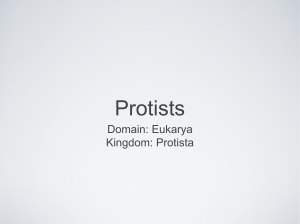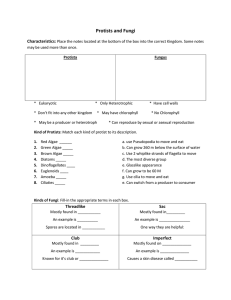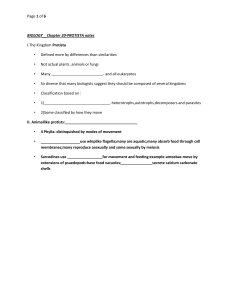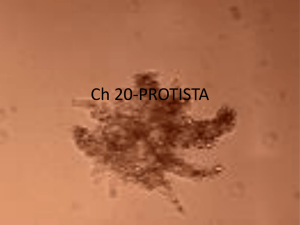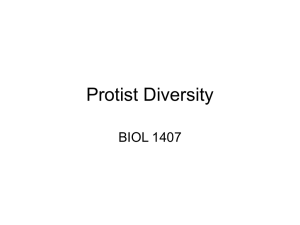3/22/2011
advertisement
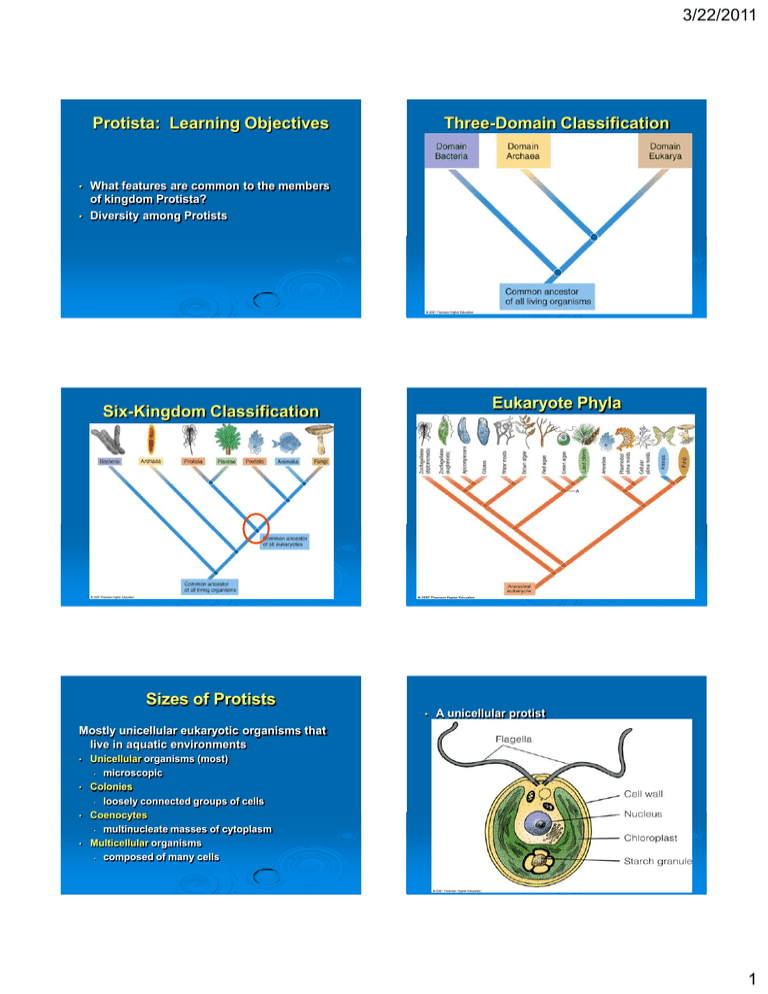
3/22/2011 Protista: Learning Objectives Three-Domain Classification • What features are common to the members of kingdom Protista? • Diversity among Protists Eukaryote Phyla Six-Kingdom Classification Sizes of Protists • A unicellular protist Mostly unicellular eukaryotic organisms that live in aquatic environments • • • • Unicellular organisms (most) • microscopic Colonies • loosely connected groups of cells Coenocytes • multinucleate masses of cytoplasm Multicellular organisms • composed of many cells 1 3/22/2011 Locomotion Diversity in the Kingdom Protists. • Classification based on: • means of locomotion • modes of nutrition • interactions with other organisms • habitats • modes of reproduction • Pseudopodia Flagella • Cilia • Some are nonmotile • Nutrition Interactions • • • • Protists are free-living or symbiotic Symbiotic relationships vary - A close relationship between 2 unrelated organisms Mutualism + + Commensalism + Parasitism + - Protists are: Heterotrophs • Autotrophs Habitats • • Most protists live in • ocean • freshwater ponds • lakes • streams Reproduction • Many protists reproduce both sexually and asexually • Others reproduce only asexually Parasitic protists live in body fluids of hosts 2 3/22/2011 Relationships Among Protists Chloroplast Evolution • Protist kingdom • paraphyletic group: - group of orgs with common ancestor and some but not all of its descendents • Determined by • ultrastructure (electron microscopy) • comparative molecular data Eukaryote Phyla Giardia Protists are descendants of early eukaryotes Discicristates Trichonympha – live in gut of termites Nucleus Flagella 50 µm Fig. 25-5b, p. 536 3 3/22/2011 Ciliates Cilliates - Conjugation Dinoflagellates Plasmodium A Water Mold Diatoms: some form floating plankton 4 3/22/2011 Heterokonts: Golden Algae Heterokonts: Brown Algae • Multicellular - important in cooler ocean waters • Kelps (largest brown algae) • • • • • Brown Algae Foraminiferans Cercozoa: Actinopods Plants Mostly marine plankton • Monophyletic group including • • • Obtain food with axopods • leaflike blades stemlike stipes anchoring holdfasts gas-filled bladders for buoyancy slender cytoplasmic projections • • red algae green algae land plants Based on • • molecular data presence of chloroplasts bounded by outer and inner membranes 5 3/22/2011 Red Algae: Mostly multicellular seaweeds important in warm tropical ocean waters Green Algae • Wide diversity in size, structural complexity, and reproduction • Botanists hypothesize that ancestral green algae gave rise to land plants – – Green Algae – ASEXUAL – REPRODUCTION (by mitosis) – 4 Four haploid cells emerge, + two (+) and two – – (-). 5 Both mating types reproduce asexually by mitosis; only (-) strain is shown. Zoospores 1 Gametes are produced by mitosis. – SEXUAL REPRODUCTION + HAPLOID (n) GENERATION – – + from a different strain DIPLOID (2n) GENERATION + Fertilization Meiosis 3 Meiosis occurs. Zygote (2n) Amoebazoa: Amoebas 2 (+) and (-) gametes fuse, forming a diploid zygote. Fig. 25-17, p. 547 Amoebas: Use cytoplasmic extensions (pseudopodia) to move and obtain food by phagocytosis Green alga • Entamoeba histolytica • • parasitic amoeba causes amoebic dysentery Pseudopodia 100 µm Fig. 25-22, p. 549 6 3/22/2011 Plasmodial Slime Molds Omoebozoa: • Feeding stage is multinucleate plasmodium Slime molds Opisthokonts: Choanoflagellates • • • single posterior flagellum in flagellate cells collar of microvilli surrounds base of flagellum Choanoflagellates • are related to fungi and animals Choanoflagellate 7

